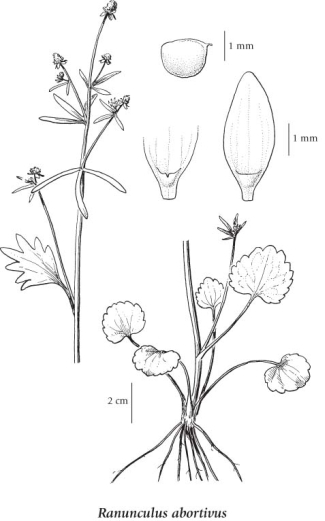Ranunculus abortivus L.
kidney-leaved buttercup (littleleaf buttercup)
Ranunculaceae (Buttercup family)
Introduction to Vascular Plants
kidney-leaved buttercup (littleleaf buttercup)
Ranunculaceae (Buttercup family)
Introduction to Vascular Plants
Species Information click to expand contents
General:
Biennial or short-lived perennial herb from a cluster of fibrous roots; stems usually single, erect or nearly so, 10-60 cm tall, smooth, hollow.
Leaves:
Basal, persistent, round to kidney-shaped, not divided, but sometimes inner ones 3-parted or -lobed, 1.5-4 cm long, 2-5 cm wide, base shallowly to deeply notched, margins round-toothed to round-lobed, the stalks up to 10 cm long; lower stem leaves similar to basal, but often deeply 3-lobed or -parted; upper stem leaves and bracts divided into 3 to 5 linear or narrowly lanceolate, entire segments.
Flowers:
Inflorescence a 3- to 50-flowered cyme; flower stalks to 10 cm long, smooth or nearly so; receptacle sparsely long-hairy; petals 5, distinct, yellow, fading to white, 1.5-3.5 mm long, 1-2 mm wide, nectary on upper surface, the nectary scale smooth, 0.5-0.7 mm long; sepals 5, spreading to bent back, early deciduous, greenish-yellow and usually purplish-tinged, 2.5-4 mm long, 1-2 mm wide, smooth above; stamens 15-30; pistils 20-40 (50).
Fruits:
Achenes, 20 to 50 in an egg-shaped head 3-6 mm long, 2.5-5 mm wide, the achenes egg-shaped, 1.4-1.6 mm long, 1-1.5 mm wide, smooth; beaks awl-shaped, curved, 0.1-0.2 mm long.
Illustration click to expand contents

If more than one illustration is available for a species (e.g., separate illustrations were provided for two subspecies) then links to the separate images will be provided below. Note that individual subspecies or varietal illustrations are not always available.
Illustration Source: The Illustrated Flora of British Columbia
USDA Species Characteristics click to expand contents
Flower Colour:
Yellow
Blooming Period:
Spring
Fruit/Seed characteristics:
Colour: Black
Present over the Summer
Source: The USDA
Ecology click to expand contents
Ecological Framework for Ranunculus abortivus
The table below shows the species-specific information calculated from
original data (BEC database) provided by the BC Ministry of Forests and Range.
(Updated August, 2013)
The table below shows the species-specific information calculated from
original data (BEC database) provided by the BC Ministry of Forests and Range.
(Updated August, 2013)
| Site Information |
Value / Class |
||
|
Avg |
Min |
Max |
|
| Elevation
(metres) |
818 | 450 | 1075 |
| Slope
Gradient (%) |
3 | 0 | 25 |
|
Aspect (degrees) |
279 | 20 | 320 |
| Soil
Moisture Regime (SMR) [0 - very xeric; 4 - mesic; 8 - hydric] |
5 | 4 | 7 |
| Modal
Nutrient Regime
Class |
D | ||
| #
of field plots species was recorded in: |
11 | ||
| Modal
BEC Zone Class |
SBS | ||
|
All BEC Zones (# of stations/zone) species was recorded in |
ICH(1), IDF(3), SBS(6), SWB(1) | ||
|
Source:
Klinkenberg 2013
|
|||
Habitat and Range click to expand contents
Wet to moist clearings, meadows, streambanks, shores and ditches from the lowland to subalpine zones; frequent throughout BC east of the Coast-Cascade Mountains, rare along the coast; N to AK, YT and NT, E to NF and S to ID, CO, FL, TX and WA, Cuba.
Status Information click to expand contents
Synonyms click to expand contents
Synonyms and Alternate Names:
Ranunculus abortivus subsp. acrolasius (Fernald) Kapoor & A. Löve & D. Löve
Ranunculus abortivus var. abortivus
Ranunculus abortivus var. acrolasius Fernald
Ranunculus abortivus var. eucyclus Fernald
Ranunculus abortivus var. indivisus Fernald
Ranunculus abortivus var. typicus Fernald